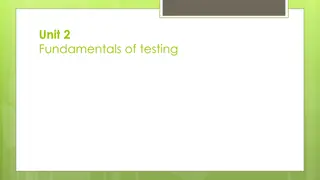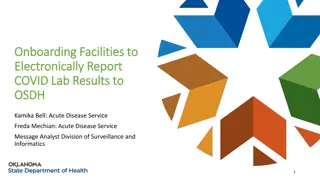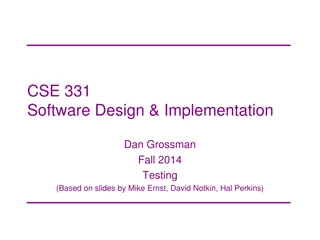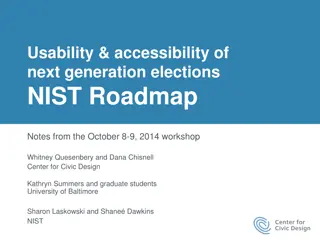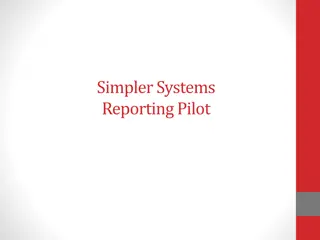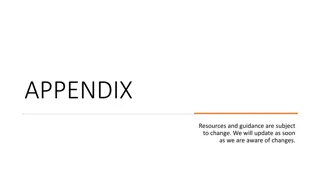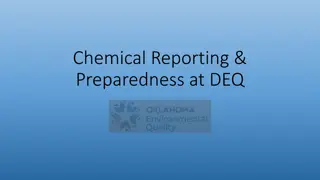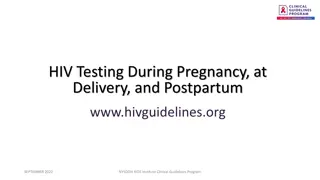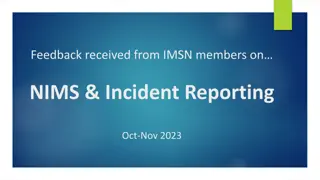Usability Testing Planning and Reporting Notes
In this comprehensive guide, learn about developing usability testing plans, writing test reports, and navigating human research ethics when conducting studies. The guide covers planning details, scenarios, metrics, task design, and selection essential to successful usability evaluations.
Download Presentation

Please find below an Image/Link to download the presentation.
The content on the website is provided AS IS for your information and personal use only. It may not be sold, licensed, or shared on other websites without obtaining consent from the author. Download presentation by click this link. If you encounter any issues during the download, it is possible that the publisher has removed the file from their server.
E N D
Presentation Transcript
Usability Testing Planning and Reporting Notes from http://www.usability.gov/methods/test_refine/learnusa/testplan.html 1
This is too good to miss http://www.youtube.com/watch?v=sfSJP8avHWI 2 Usability Evaluations
Learning objectives Be able to develop usability testing plans Be able to write usability test reports Understand the nature of human research ethics requirements when conducting studies on humans 3 Usability Evaluations
Plan EVERYTHING Use a template such as at http://www.usability.gov/methods/test_refine/learnusa/testplan.html Fill in ALL the bits even those that are completely obvious
Details Scope Name of application or website How much or what are you testing Purpose Broad Can users complete the order? Narrow Can they find the shopping basket? Schedule & Location When and where Sessions How long (should be less than one hour) Equipment Exactly what equipment is needed Computer(what), video, Morae Participants What type of people are you looking for Typical users? Convenience participants (e.g. students, other employees)
Details Scenarios How many and what type of tasks (see next slide) Metrics What will you measure/collect Errors Time Observations Questionnaire Roles How many people do you need? Participant guide Observer
Task Design Be specific* enrol in COMPSCI345 at the University of Auckland what lecture room(s) are COMPSCI345 lectures in? Record Completion Paths Step through the task yourself Record different routes to successfully complete Time yourself Note things you think are difficult or confusing You are, in effect doing a Heuristic Evaluation (assignment 1 is pretty much this with thorough documentation and a heuristic evaluation template) Remember these are notoriously inaccurate (users will surprise you) Do not show these to participants * See next slide
Task Selection Utterly central to what you will learn in the usability test There just isn t time / resources to do usability testing on everything Select the tasks that are make-or-break for the application You re looking for the risk What s novel? What will differentiate this product? If you re in a safe zone where you re emulating well- established interaction patterns, then you ll learn less Then again, still can be important to check that you got it right! 8 Usability Evaluations
Task Order For you assignment you need to think carefully about task order. Do you want to fix the order eg everyone does cash, then credit card then txt Do you want to latin square eg every variation of order (there are six) What do you think the difference would be? This is called the learning effect. 9 Usability Evaluations
Questionnaire The easiest way to gather satisfaction data is a questionnaire There are several standard questionnaires http://www.usabilitynet.org/trump/documents/Suschapt.doc http://www.w3.org/WAI/EO/Drafts/UCD/questions.html#posttest
Questionnaire open and closed Open questions (as per previous slide) give you rich qualitative data Best for finding the seeds of resolutions to problems Closed questions allow you to quantify Would you recommend this website to a friend? [Circle one] YES NO Yes/No is OK, but better to use Likert scale This website is easy to use: Strongly Agree Agree Disagree Strongly Disagree Converts to scores (1-4, 1-7, etc.), can report mean and other statistics and graphs There s a whole world to writing questionnaires; starter: http://www.terry.uga.edu/~rgrover/chapter_5.pdf 11 Usability Evaluations
Logistics Don t under-estimate the practical problems If you get something wrong you can lose a lot of time (and, in most situations, money) having to reschedule Running a quick pilot or walkthrough can help here Have you figured out How to pay / reward participants? Any catering for longer session (including your staff if the experiment is in the field )? Do you have enough power points and battery life? Enough storage capacity (e.g. on your digital camera)? The time and ability to reset in between participants? 12 Usability Evaluations
Details (not on that sample template!) Analysis plan How are you going to turn the raw observations into assessment against your usability requirements, and into recommendations? It s one thing to declare time as a metric and plan to collect video, but have you defined exactly which elements of the task you are timing, and the protocol for marking the task time? Is your method practical and accurate? Will it support the overall purpose of your usability test What is your plan for how to report the findings What, to whom, when and toward what follow-up action? 13 Usability Evaluations
Half time entertainment https://www.youtube.com/watch?v=3Qg80qTfzgU 14 Usability Evaluations
Back to the test plan Write a Script Script the usability study EXACTLY Greeting Ethics Task instructions Questionnaire If you don t have a script you WILL get lazy and miss instructions for later participants.
Pilot Test Try the whole thing out on one or two people (or more if it s a really important and large usability study) After first person fix obvious problems If very few corrections needed in test plan then you can go straight to testing But it is much better to do a second pilot than discover major problems half way through
Analyse Results Task time and success Errors you ll want counts and to form categories Wrong navigation Problems finding particular features . Questionnaire analysis If around 10 people or less, show raw data, mean and standard deviation If more than 10 people, box plots or frequency distribution graphs might be appropriate
Think! The big picture What have you found? What is worth fixing? Is there a business case? How could the problems be alleviated?
Report Document Detailed report of everything you have found Three formats here http://www.usability.gov/templates/index.html Remember numbers are very convincing, compare: Several people had trouble finding the shopping basket 3 out of 7 people abandoned the task because they couldn t find the shopping basket. For the other 4 the average time to find the shopping basket was 3.59seconds (longest 8.0 seconds) Video Imagine clipping together the 7 people looking for the shopping basket icon with puzzled looks on their faces!
Ethics If you are doing a study with living (human or animal) participants in a university you will probably need ethics approval Can be quite a lot of paperwork, and takes a while to get an answer (which is usually to revise and re-submit!) You will need such approval for a study to be part of your dissertation or thesis Many journals require such approval to publish Quite a few companies have similar requirements This is why for your assignment you are not testing on others though you could ask classmates
Research ethics basics Informed consent Participant knows what they are in for Task, time, why you re doing it (even though you may be allowed to deceive them about some aspect of the task) Confidentiality of their data Compensation (if any) Participant is clear that they are not compelled to participate This is a bit of a trick in lecturers experimenting on their students! (or doctors on patients, or bosses on their employees) They need to know that they can refuse, or withdraw (even retrospectively!) without jeopardising the key service (healthcare, education, employment) Anonymous questionnaires, esp. in public, are probably the easiest from an ethics perspective Usability Evaluations 21
Ethics application Explains protocol and goals: essentially like a test plan And so it s helpful to complete one because it acts as a check on your plan Particular focus on issues such as who has access to the data and the risk (and benefits, if any) to participants Research organisations (University, District Health Board) have standing committees to review applications Have representatives from a range of perspectives: clinical, legal, statistical (and Maori in NZ) 22 Usability Evaluations
Professionalism (in usability test reporting) Treat participants with respect Assume they are not idiots, it is the software that is wrong Treat developers with respect They may have put their heart and soul into the product and worked overtime to get if finished for you to pull it apart Make sure your report is Fair and accurate Tidy Free from grammar and spelling errors
In the real world If you can t do a real usability test Get your mates, Mum, Dad, Aunty Flo to try it Tune-in to your own usability experiences Note what was really easy that s a sign of good usability Note what is annoying you Note when you are trying to do something you have done before and can t remember how.
Summary Evaluate usability early and often in development and [preferably staged] roll-out Also evaluate alternatives before making a decision to purchase/adopt a system In more formal settings, you need a complete and detailed testing plan Heuristic evaluation is a handy intermediate level between just asking a couple people for feedback and doing a full-blown usability study 25 Usability Evaluations










